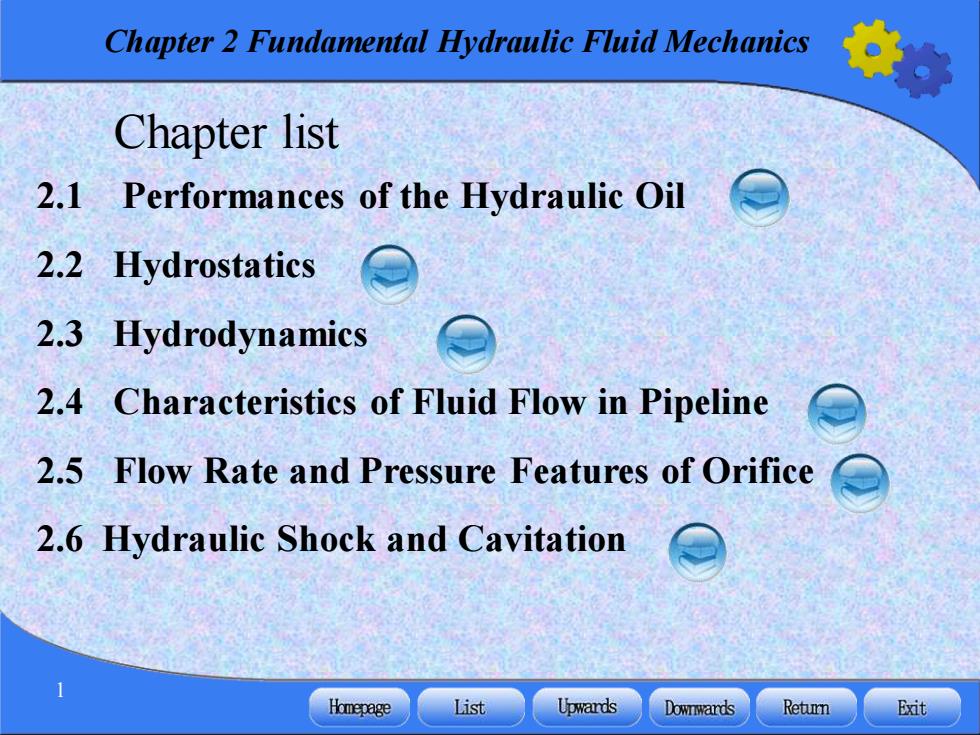
Chapter 2 Fundamental Hydraulic Fluid Mechanics Chapter list 2.1 Performances of the Hydraulic Oil 2.2 Hydrostatics 2.3 Hydrodynamics 2.4 Characteristics of Fluid Flow in Pipeline 2.5 Flow Rate and Pressure Features of Orifice 2.6 Hydraulic Shock and Cavitation Homepage List Upwards Downwards Retun Exit
Chapter 2 Fundamental Hydraulic Fluid Mechanics 1 2.1 Performances of the Hydraulic Oil 2.2 Hydrostatics 2.3 Hydrodynamics 2.4 Characteristics of Fluid Flow in Pipeline 2.5 Flow Rate and Pressure Features of Orifice 2.6 Hydraulic Shock and Cavitation Chapter list
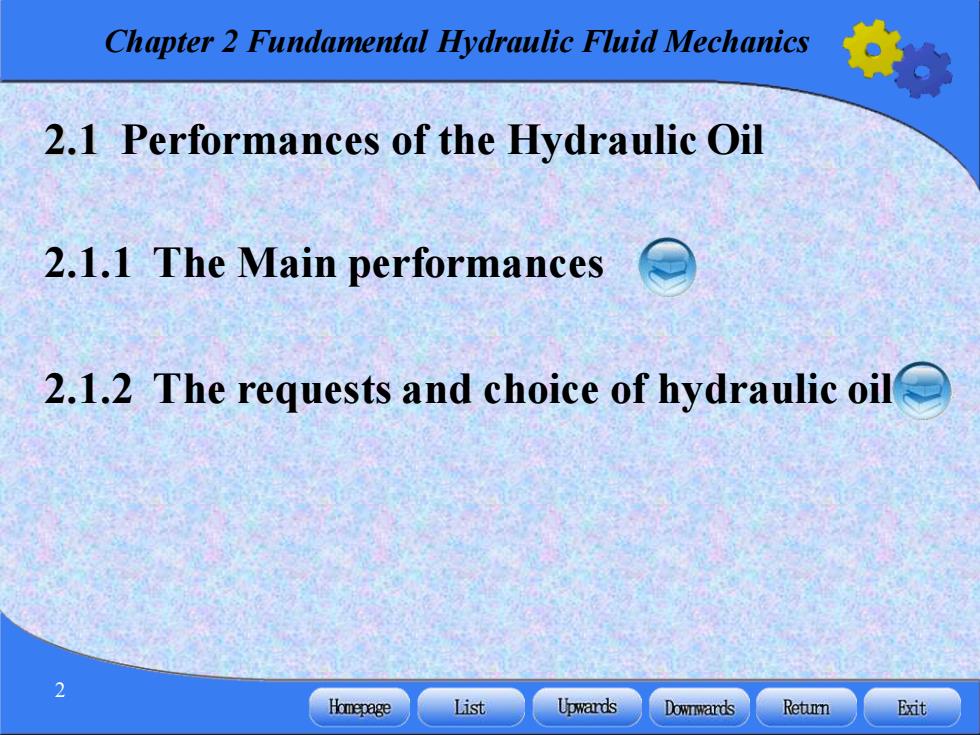
Chapter 2 Fundamental Hydraulic Fluid Mechanics 2.1 Performances of the Hydraulic Oil 2.1.1 The Main performances 2.1.2 The requests and choice of hydraulic oil Homepage List Upwards Downwards Retumn Exit
Chapter 2 Fundamental Hydraulic Fluid Mechanics 2 2.1.1 The Main performances 2.1.2 The requests and choice of hydraulic oil 2.1 Performances of the Hydraulic Oil
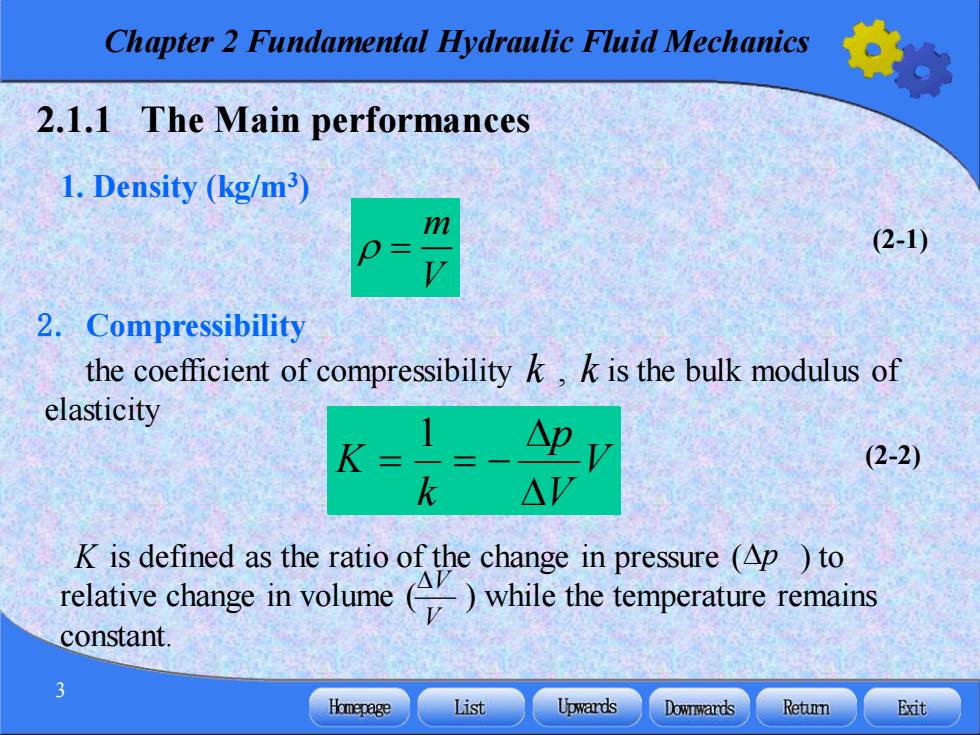
Chapter 2 Fundamental Hydraulic Fluid Mechanics 2.1.1 The Main performances 1.Density (kg/m3) (2-1) 2.Compressibility the coefficient of compressibility k,k is the bulk modulus of elasticity (2-2) △V K is defined as the ratio of the change in pressure (Ap )to relative change in volume (while the temperature remains constant 3 Homepage List Upwards Downwards Retumn Exit
Chapter 2 Fundamental Hydraulic Fluid Mechanics 3 1. Density (kg/m3 ) 2. Compressibility 2.1.1 The Main performances V V p k K = = − 1 the coefficient of compressibility , is the bulk modulus of elasticity (2-2) (2-1) k is defined as the ratio of the change in pressure ( ) to relative change in volume ( ) while the temperature remains constant. V V p m V = k K
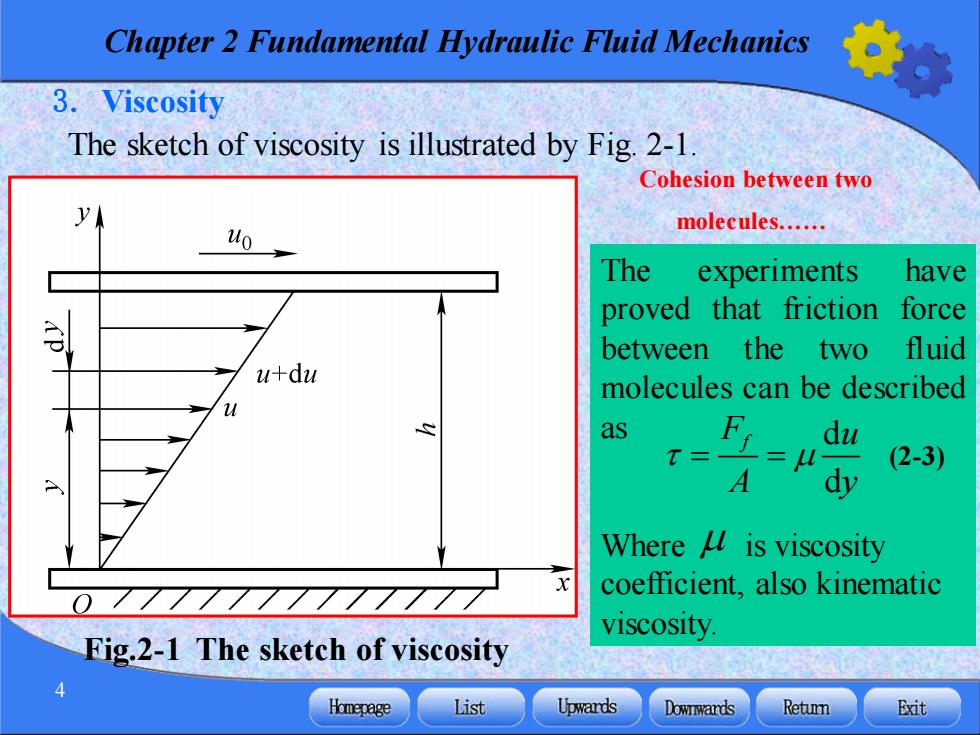
Chapter 2 Fundamental Hydraulic Fluid Mechanics 3.Viscosity The sketch of viscosity is illustrated by Fig.2-1 Cohesion between two uo molecules. The experiments have proved that」 friction force between the two fluid u+du molecules can be described as du 2-3) A dy Where is viscosity coefficient,also kinematic viscosity Fig.2-1 The sketch of viscosity Homepage List Upwards Downward达s Retumn Exit
Chapter 2 Fundamental Hydraulic Fluid Mechanics 4 3. Viscosity The experiments have proved that friction force between the two fluid molecules can be described as Where is viscosity coefficient, also kinematic viscosity. Fig.2-1 The sketch of viscosity d d Ff u A y = = The sketch of viscosity is illustrated by Fig. 2-1. (2-3) Cohesion between two molecules
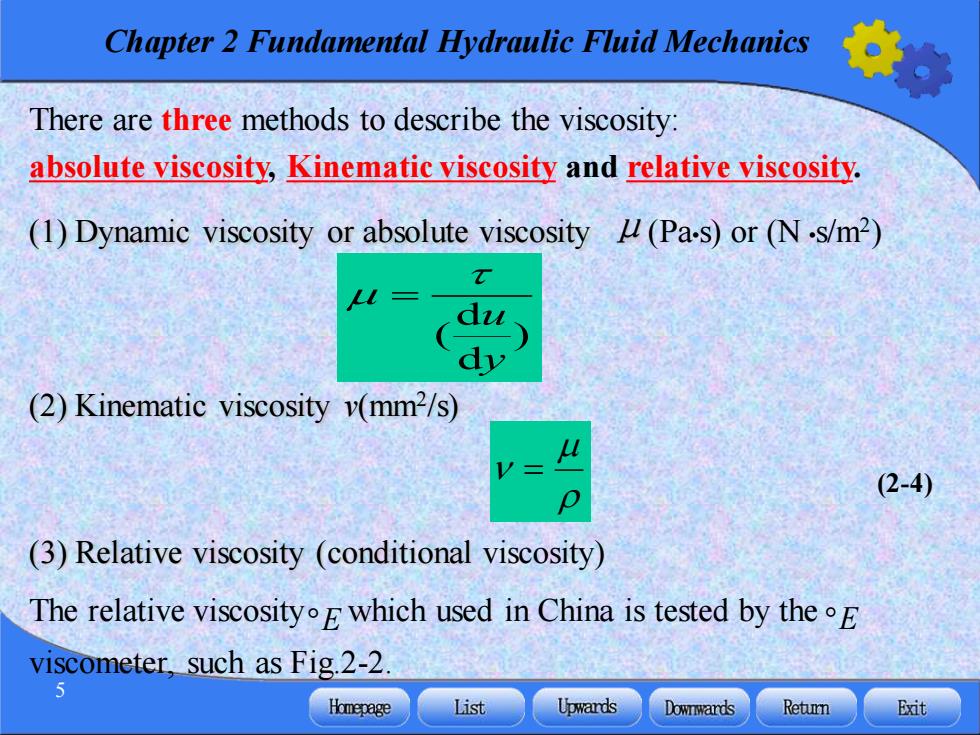
Chapter 2 Fundamental Hydraulic Fluid Mechanics There are three methods to describe the viscosity: absolute viscosity,Kinematic viscosity and relative viscosity. (1)Dynamic viscosity or absolute viscosity (Pa-s)or (N-s/m2) dy (2)Kinematic viscosity v(mm2/s) p (2-4) (3)Relative viscosity (conditional viscosity) The relative viscosityowhich used in China is tested by theE viscometer,such as Fig.2-2 5 Homepage List Upwards Downwards Retumn Exit
Chapter 2 Fundamental Hydraulic Fluid Mechanics 5 There are three methods to describe the viscosity: absolute viscosity, Kinematic viscosity and relative viscosity. (1) Dynamic viscosity or absolute viscosity μ(Pa•s) or (N •s/m2 ) (2) Kinematic viscosity ν(mm2 /s) = d ( ) d u y = (2-4) (3) Relative viscosity (conditional viscosity) The relative viscosity which used in China is tested by the viscometer, such as Fig.2-2. E E
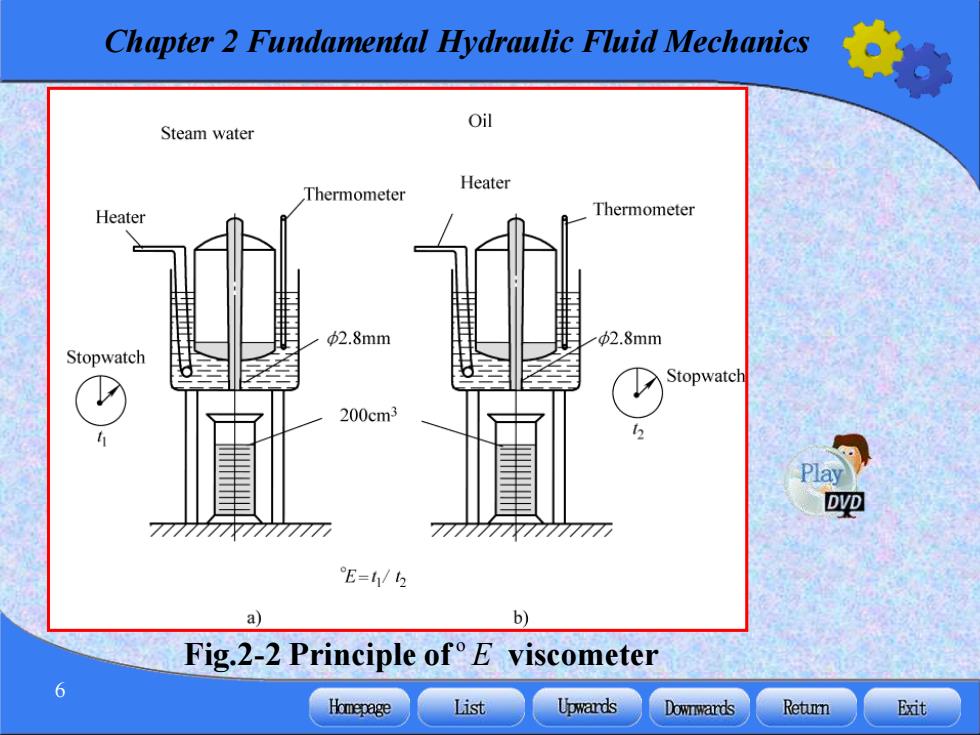
Chapter 2 Fundamental Hydraulic Fluid Mechanics Oil Steam water Heater Thermometer Heater Thermometer 中2.8mm 2.8mm Stopwatch Stopwatch 200cm3 Play 吧 E=4/2 a) b) Fig.2-2 Principle ofE viscometer Homepage List Upwards Downwards Retumn Exit
Chapter 2 Fundamental Hydraulic Fluid Mechanics 6 Fig.2-2 Principle of viscometer o E

Chapter 2 Fundamental Hydraulic Fluid Mechanics Take the noteEdescribes the viscosity: °E=t/t2 (2-5) The conversion formula between theE and kinematic viscosity is V=(7.31°E- 6.31 )×106 (m/s) (2-6) E (4)Viscosity-temperature:For the viscosity less than 15E and the temperature 30C~150C,the viscosity-temperature formula is describe as following(We can also look up from Fig2-3): (2-7) (5)Viscosity-pressure V。=Uep≈y(1+0.03p) (2-8) (6)Others performances:physical and chemical,such as anti-inflammability, anti-oxygenation,anti-concreting,anti-foam and anti-corrosionetc Homepage List Upwards Dowrwards Retumn Exit
Chapter 2 Fundamental Hydraulic Fluid Mechanics 7 Take the note describes the viscosity: The conversion formula between the and kinematic viscosity is (m2/s) o 6 o 6.31 (7.31 ) 10 E E − = − o E t t t 1 2 = / (4) Viscosity-temperature : For the viscosity less than 15 and the temperature 30 。 C ~150 。 C, the viscosity-temperature formula is describe as following (We can also look up from Fig.2-3): 50 50 ( )n t t = (2-5) (2-6) (2-7) (5) Viscosity-pressure p 0 0 (1 0.03 ) bp = + e p (2-8) (6) Others performances: physical and chemical, such as anti-inflammability, anti-oxygenation, anti-concreting, anti-foam and anti-corrosion etc o Et o E o E
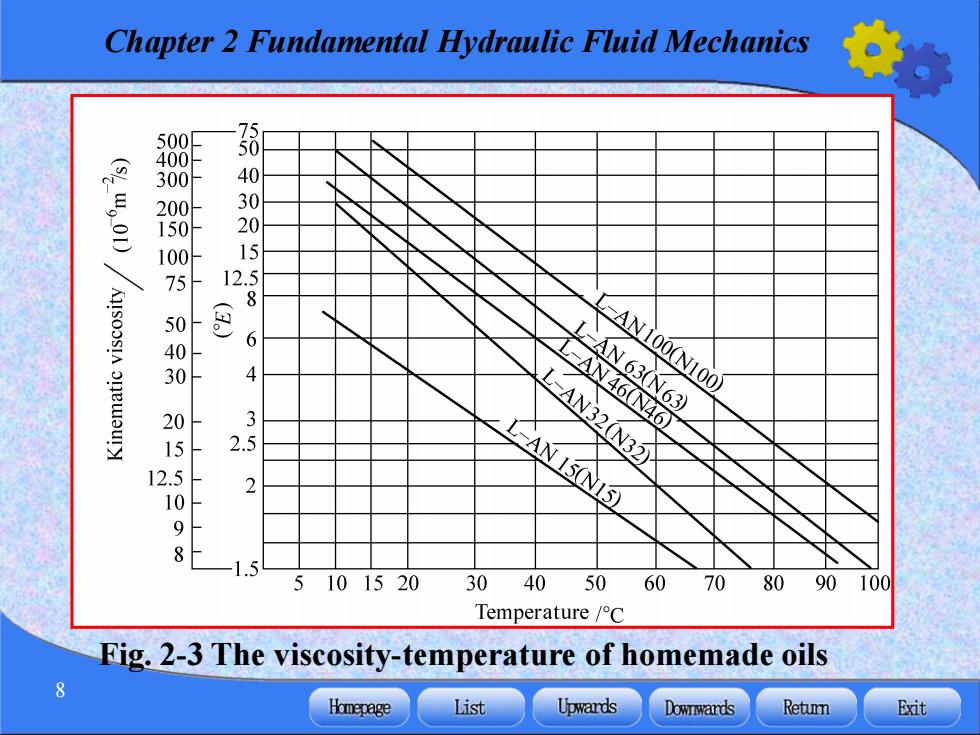
Chapter 2 Fundamental Hydraulic Fluid Mechanics 60060002500 5000205 6 -ANi00N100 20 LAN G3N63 3 -AN46N46 2.5 LAN32(N32 12.5 2 LANLNIS 098 -1.5 5 101520 30 40 50 60 70 8090 100 Temperature/C Fig.2-3 The viscosity-temperature of homemade oils 8 Homepage List Upwards Downwards Retun Exit
Chapter 2 Fundamental Hydraulic Fluid Mechanics 8 Fig. 2-3 The viscosity-temperature of homemade oils
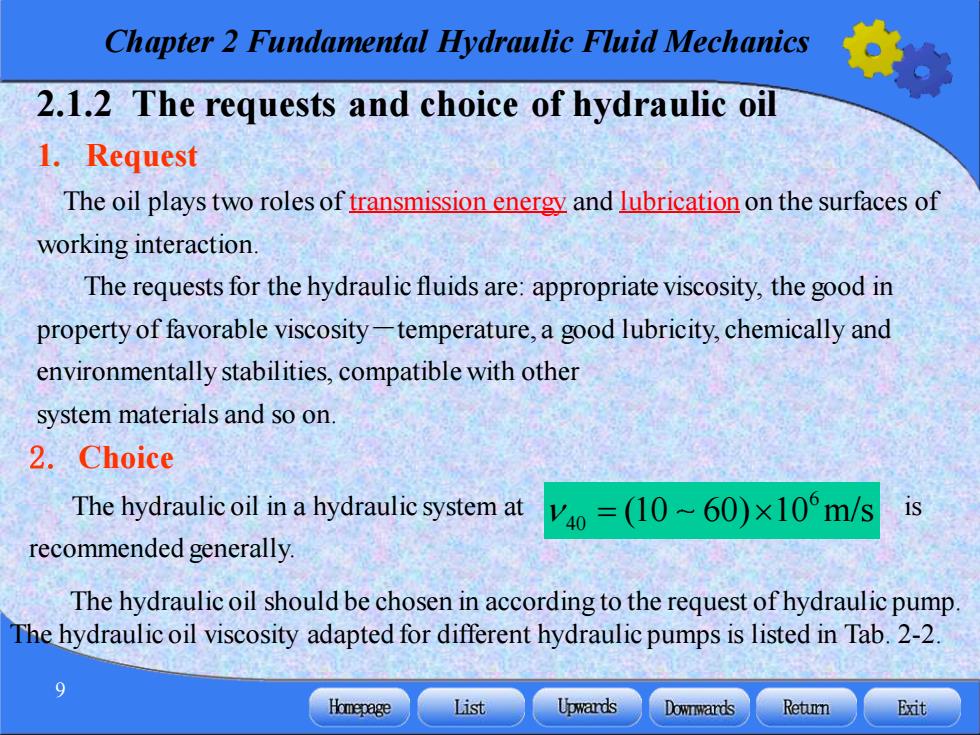
Chapter 2 Fundamental Hydraulic Fluid Mechanics 2.1.2 The requests and choice of hydraulic oil 1.Request The oil plays two roles of transmission energy and lubrication on the surfaces of working interaction The requests for the hydraulic fluids are:appropriate viscosity,the good in property of favorable viscosity-temperature,a good lubricity,chemically and environmentally stabilities,compatible with other system materials and so on 2.Choice The hydraulic oil in a hydraulic system at V4o=(10~60)×10°m/s recommended generally. The hydraulic oil should be chosen in according to the request of hydraulic pump The hydraulic oil viscosity adapted for different hydraulic pumps is listed in Tab.2-2. Homepage List Upwards Downwards Retumn Exit
Chapter 2 Fundamental Hydraulic Fluid Mechanics 9 2. Choice The hydraulic oil in a hydraulic system at is recommended generally. 1. Request The oil plays two roles of transmission energy and lubrication on the surfaces of working interaction. The requests for the hydraulic fluids are: appropriate viscosity, the good in property of favorable viscosity-temperature, a good lubricity, chemically and environmentally stabilities, compatible with other system materials and so on. 2.1.2 The requests and choice of hydraulic oil The hydraulic oil should be chosen in according to the request of hydraulic pump. The hydraulic oil viscosity adapted for different hydraulic pumps is listed in Tab. 2-2. 6 40 = (10 60) 10 m/s

Chapter 2 Fundamental Hydraulic Fluid Mechanics Tab.2-2 The range of viscosity of hydraulic oil adapted to pumps viscosities(10-6m2/s) Viscosities(10-6m2/s) Types 540℃ 40~80℃ Types 5~40℃ 4080℃ ① ① ① ① P<7MPa 30~50 40~75 Gear 30~70 95≈165 pumps Vane Pumps Radial P≥7MPa 50~70 50~90 piston 30~50 65240 pumps Axial Screw pumps 30~50 40~80 piston 3070 70~150 pumps D5~40C.40-80C are described the temperatures of hydraulic system. 10 Homepage List Upwards Dowrwards Retumn Exit
Chapter 2 Fundamental Hydraulic Fluid Mechanics 10 Tab. 2-2 The range of viscosity of hydraulic oil adapted to pumps Types viscosities (10-6 m2 /s) Types Viscosities(10-6 m2 /s) 5~40℃ ① 40~80℃ ① 5~40℃ ① 40~80℃ ① Vane Pumps P< 7MPa 30~50 40~75 Gear pumps 30~70 95~165 P≥7MPa 50~70 50~90 Radial piston pumps 30~50 65~240 Screw pumps 30~50 40~80 Axial piston pumps 30~70 70~150 ①5~40℃、40~80℃are described the temperatures of hydraulic system